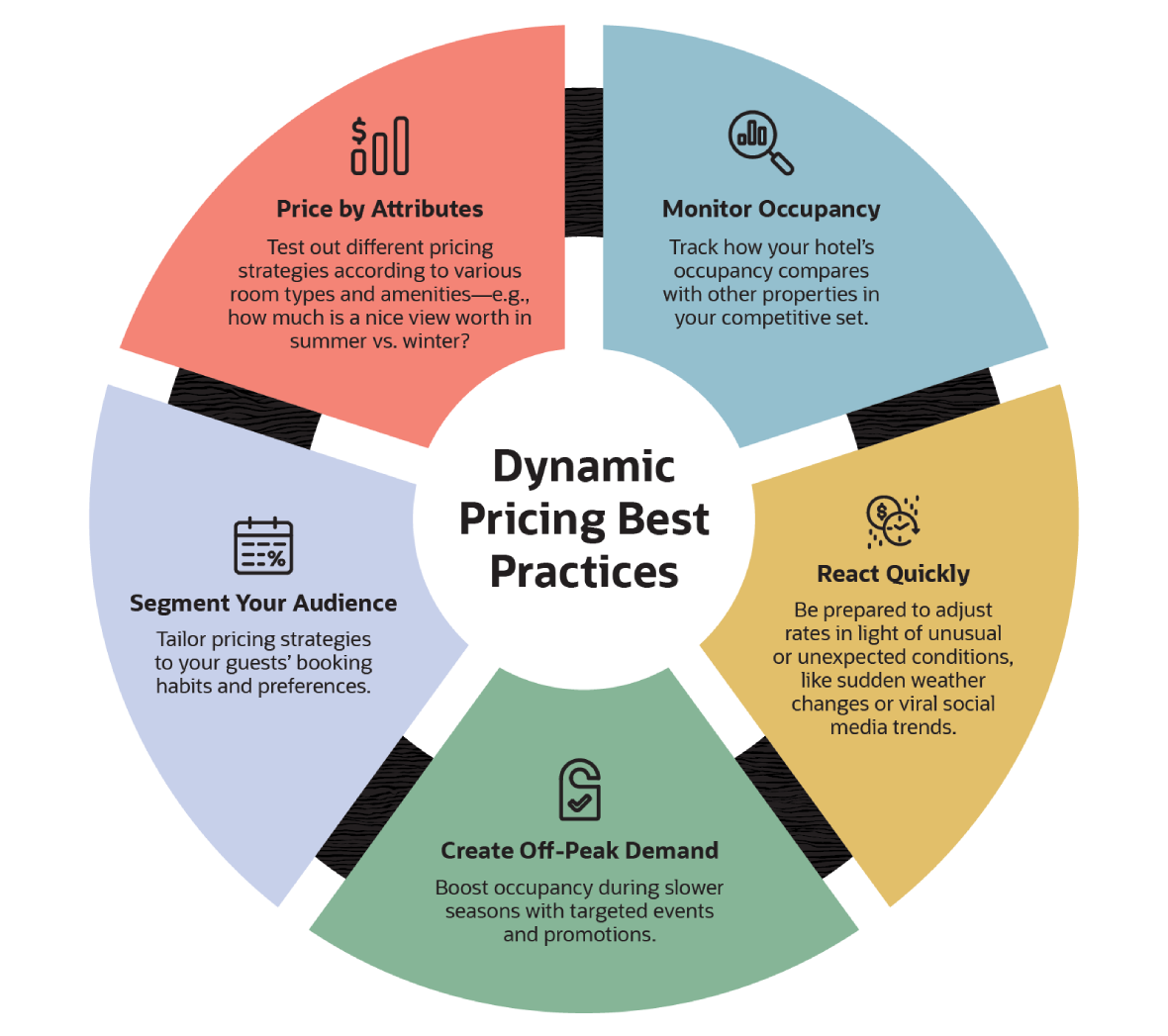Hotel room price fluctuations based on the day of the week or time of year should no longer surprise travelers. This type of revenue strategy—called dynamic pricing—has been around for decades in the hotel industry. It has also become the norm for airlines and, more recently, for ticketed events, ride-sharing services, and restaurants.
Dynamic pricing is essentially the law of supply and demand on full display, in real time. When implemented properly it can benefit both the company and the customer.
What Is Dynamic Pricing for Hotels?
For hotels, dynamic pricing refers to the process of continually adjusting room rates based on factors such as the day of the week, seasonality, special events, length of stay, what the competition is doing, weather, and location—all of which can affect supply and demand. The goal is to set the best pricing in both peak times and slow times by adapting rates to match customer demand. Specifically, hotels tend to charge higher rates during busy times to maximize revenue and lower rates during slow periods to incentivize bookings.
Key Takeaways
- Customer demand is among the biggest drivers of hotel dynamic pricing.
- Whether it means charging a higher room rate during peak times or scaling back rates to incentivize stays during the offseason, the goal is to boost revenue and profitability.
- Software tools and algorithms can be used to automate the process of changing prices based on demand, competition, events, weather, and other factors.
Hotel Dynamic Pricing Explained
Dynamic pricing aims to ensure that hotels consistently offer the most competitive room rates in real time, using customer demand to drive the price. The opposite is static pricing, where room rates don’t change despite demand variables.
When demand for hotel rooms is high, properties can charge more, as customers are generally willing to pay a premium to secure a room. When demand is low, hotels can lower their rates to attract price-sensitive customers and fill rooms that would otherwise remain empty. In either case, dynamic pricing offers hotels a flexible approach to generate more revenue with each booking, while still meeting guests’ needs.
How Does Dynamic Pricing Work in Hotels?
To effectively implement dynamic pricing, hotels must constantly monitor the market and adjust their rates accordingly. The property’s management typically tracks the market daily and weekly to look for trends and notable fluctuations, giving them the opportunity to react one way or another to try to increase occupancy and maximize revenue. Dynamic pricing tools exist for hotels to develop and manage algorithms that suggest pricing changes for their rooms. The adjustments are based on historical data, current trends, competitive pricing, and demand. This software, essentially a hotel revenue management system (RMS) designed to help hotels make pricing and inventory decisions, usually works in conjunction with the hotel’s property management system (PMS) and supports effective hotel revenue management.
Here’s an example of how dynamic pricing can work in a hotel. Let’s begin with a list of standard nightly room rates for a hypothetical hotel:
- Weekday: $175
- Weekend: $225
- Peak season: $250
Now, the scenario: The NFL releases its schedule for the upcoming season, and fans are ready to book trips to watch their favorite teams play in different cities. If the hotel keeps its standard rates, rooms might sell out quickly, but the hotel would be leaving money on the table, because with a dynamic pricing model, the room rate could jump to $275 or $300 during this premium time.
Then, as the game date draws closer and hotel availability in the area decreases as demand grows, rates can continue to increase for that specific period. To entice more customers, the hotel might also design special packages for the game weekend or encourage extended stays by offering discounted rates for Friday night too, incentivizing guests to opt for an earlier arrival and a full weekend stay.
The same concept can apply to concerts, conventions, school breaks, and other notable events that draw a great number of out-of-town attendees.
Benefits of Hotel Dynamic Pricing
The overarching goal of hotel dynamic pricing is to maximize room bookings and revenue during the various ebbs and flows of customer behavior. But the benefits of implementing such a pricing strategy go beyond financial considerations.
- Maximized revenue: This applies to both sides of the demand arc. When demand is high, the market has more customers willing to pay higher rates for a room. When demand is low, adjusting rates to or below the market rate can attract more guests to your hotel over a competitor’s. The idea is to minimize the number of unsold rooms and to maximize revenue opportunities.
- Improved occupancy rates: Lowering room rates during times of lower demand, whether due to seasonality or day of the week, can make the hotel more appealing to potential guests. Dynamic pricing can convert searchers into purchasers, boosting both occupancy rate and revenue per available room (RevPAR).
- Increased competitive advantage: Dynamic pricing empowers hotels to respond quickly to market changes and competitor pricing by altering rates in real time. This can help hotels attract more guests and maximize revenue, giving them an edge over competitors that use more static pricing models.
- Enhanced customer segmentation: The algorithm used to determine when and how to adjust room rates also can be used to learn about different customer segments. What is this audience’s booking pattern, and how might that compare to another segment? How does the average length of stay vary based on room rates across different segments? Special occasions, events, and seasonality also can be measured across segments to better understand consumer behavior. This data can influence strategies aimed at attracting new hotel customers.
- Increased profit margins: Filling rooms by pricing them at lower rates during slower times puts more money in the till. Upping prices to take advantage of greater demand, like during the summer or around holiday seasons, does the same. Together, the associated revenue growth leads to increased profit margins assuming a consistent cost base. The more a hotel can increase its occupancy rate, average daily rate, and RevPAR, the more likely it is to boost its gross operating profit per available room.
- Improved forecasting: Analyzing historical data and watching current trends can help a hotel accurately predict busier and slower times. This makes it possible to adjust pricing proactively to boost revenue and to support decisions concerning supply inventory, staffing needs, and potential promotions. Such improvement in hotel forecasting can also lead to better short- and long-term performance. And it helps with budgeting.
How to Implement Dynamic Pricing at Your Hotel
Most hotels have been using some form of dynamic pricing for their guests for decades. But as with so many other processes, technology has changed the way business is conducted and pricing strategies are implemented. Here are 10 steps for effective implementation of dynamic pricing in the hotel industry.
1. Assess Your Current Pricing Strategy
Pricing strategy refers to the way in which a hotel chooses to charge guests for its rooms and services. Does the hotel keep its rates relatively static on weekdays and weekends for most of the year? Do rates fluctuate based on occupancy levels? Are prices raised just a bit during peak times? Understanding your current pricing approach will provide a greater sense of where dynamic pricing could be leveraged to increase revenues and improve profitability.
2. Invest in Technology
A property management system handles day-to-day operations, such as reservations and check-ins, while a revenue management system is used to optimize pricing and inventory decisions. Both the PMS and RMS must be able to talk to each other to implement automatic rate changes, which is the most efficient way to employ a dynamic pricing strategy. If the two systems can’t work together in real time, employees’ workloads increase, which, in turn, reduces the time they have to complete other tasks. It also introduces the possibility of human errors associated with additional data entry. Moreover, integrating these systems with your hotel’s accounting software can streamline financial reporting and provide real-time insights into how your dynamic pricing strategy affects your bottom line. The deeper the integration between these systems, the more efficiently you can implement dynamic rates across multiple distribution channels.
3. Collect and Analyze Data
Historical data sets a hotel on its journey toward a dynamic pricing strategy. That data establishes patterns in demand, including metrics such as occupancy rates, average daily rates, RevPAR, cancellation rates, and no-show rates. Then new bookings get fed into it, along with external factors, such as competitor pricing, local events, weather forecasts, and economic indicators. Collecting all the relevant metrics leads to a robust and detailed report that can be analyzed in various ways. Advanced PMSs and RMSs can automate much of this process, generating detailed reports and providing predictive analytics to help hotels make the best decisions for their needs, clientele, and external circumstances.
4. Segment Your Market
Every booking fits into a predefined customer segment, whether that depicts the business traveler, the casual sightseer, the concertgoer, or the vacationing family. Each classification brings different booking behaviors, price sensitivities, and demand patterns. By identifying these market segments, hotels can begin to understand reservation behaviors and habits to form a stronger connection to each customer type. For example, business travelers may book closer to their travel date and be less price-sensitive than leisure travelers. Such knowledge provides opportunities to offer segment-specific promotions or adjust pricing based on segment-specific demand forecasts, potentially increasing overall revenue.
5. Develop Pricing Rules and Algorithms
The right dynamic pricing software solution will allow you to enter minimum and maximum room rates—the pricing rules that set the parameters within which your prices can fluctuate. These rules can help increase revenue while ensuring that prices remain competitive. Similarly, a hotel dynamic pricing algorithm is a set of instructions that automatically adjusts prices based on predefined conditions, such as occupancy rates, booking velocity, and competitor prices. In essence, pricing rules set the boundaries, while algorithms determine where within those boundaries the price should be at any given moment. For example, an algorithm created to monitor the competition can help you price match, or perhaps come in with a lower rate, without going too low or too high.
6. Implement Real-Time Pricing Adjustments
Once you determine the dynamic pricing strategy and parameters you want the algorithm to operate within, it’s time to put it to work. Price adjustments happen continuously, without the need for manual intervention, ensuring that hotel rates are always aligned with current market conditions. If occupancy for a given night reaches 80%, for example, the algorithm could automatically increase standard rates by 10% to help capitalize on increased demand and boost revenue. If those rooms aren’t filled within 48 hours of check-in date, rates might drop 10% below the standard rate to increase the chance of filling rooms with last-minute travelers.
7. Optimize Distribution Channels
Think about all the places hotel rooms can be booked from: the hotel’s website, the hotel’s app, any number of third-party online sites, a company’s benefits website or that of a partner, travel agents, even the old-school phone call to the reservation desk. To maximize revenue in both slow and peak times, each distribution channel needs to be responsive to overall demand, as well as to demand within that specific channel. To optimize use of these channels, consider implementing channel-specific pricing strategies. For example, offering special packages on the hotel’s own website can encourage direct bookings, whereas adjusting rates on online travel agencies to reach those specific audiences and booking patterns can help capture price-sensitive travelers. The goal is to maximize revenue from each channel while effectively managing distribution costs. In many countries, however, hotels enter into rate parity contracts with their channel partners to align what they charge to customers.
8. Communicate Pricing Changes Transparently
What’s more important to building customer loyalty than establishing trust? In the hotel industry, that begins with transparency at the point of booking. Prices should be displayed clearly and accurately, as should be the reasons for dynamic pricing fluctuations. That means no hidden fees or surprises. If the hotel has a resort fee, for instance, that should be indicated as an additional charge, and it should clearly include what it covers for the guest. In the same vein, consider providing brief explanations as to why prices might vary due to demand or availability. The key is to help customers understand and feel comfortable with the dynamic nature of your pricing strategy.
9. Monitor and Evaluate Performance
Regularly review the performance of real-time adjustments to confirm that they meet your revenue goals. More specifically, pay attention to any changes in occupancy rate or revenue since the pricing strategy took effect. Are those changes positive or negative? This data should be monitored over different lengths of time (daily, weekly, monthly) for a big picture view of how price adjustments have affected customer behavior and financial metrics.
10. Adjust and Optimize Continuously
Plan to fine-tune algorithms, pricing rules, and distribution channel strategies to optimize profitability as market conditions and customer behaviors change over time. For example, if data shows that business-traveler bookings have decreased yet leisure travel is on the rise, you might adjust your pricing strategy to offer more competitive weekend rates or family packages. The more your hotel can adapt to trends and leverage available technology, the better it can take advantage of dynamic pricing to optimize revenue.
Hotel Dynamic Pricing Best Practices
To the hotel customer, dynamic pricing may look like a cash grab. But it’s a data-driven strategy that aims to balance supply and demand. When price changes are implemented effectively and transparently, it can benefit both sides through increased revenue for hotels and potential savings for customers during off-peak periods. Hotels can use a set of best practices to improve their overall financial performance and maintain customer satisfaction.
- Monitor occupancy levels: Benchmarking can help hoteliers understand how their property’s occupancy rates compare with those of competitors, which can inform how to price rooms to their advantage. If occupancy rates are low on certain days, they could lower their rates to be less than the competitors’ and thus increase demand for their property. The opposite also works. If the main competition is sold out, then a hotel can raise its pricing, since demand is higher and it’s now the main supplier. Monitoring occupancy levels of competitors can be done manually or via specialized software that collects and analyzes data automatically.
- React to unusual market conditions: Weather may wreck a vacation for travelers, but it can also boost revenue for hoteliers. By paying attention to the world around them—an abundance of flight cancellations, for example—hotels can react quickly to opportunities to host stranded travelers. Similarly, monitoring viral social media trends or major event announcements can help hotels identify surges in destination popularity and adjust prices accordingly.
- Generate demand outside of peak season: Big events in a hotel’s geographical area are an excellent way to target a new audience. Perhaps there’s a major musical artist performing at a nearby arena or stadium, or a university graduation ceremony is scheduled. By promoting their proximity to the venue and offering special packages or rates, hotels can attract event attendees who value convenience and are willing to pay for it.
- Understand guest booking patterns: Knowing how customers behave when booking a hotel can only strengthen a business. How far in advance do guests tend to book a stay? How much does that fluctuate based on audience segment? The more hoteliers can develop this data, the better they can grasp what their guests are looking for, providing a solid foundation upon which to build brand loyalty, establish a successful dynamic pricing strategy, and boost revenue.
- Test room type preferences: Some guests don’t mind the room next to the elevators. Others do. Leveraging that information can increase both revenue and guest satisfaction. Same with rooms with a view. Summertime guests may want a room where they can see the water (be it a pool, beach, or lake), allowing hotels to boost prices accordingly.

Manage Your Hotel Pricing Strategy With NetSuite
NetSuite’s unified hospitality management cloud platform offers data analytics to help build dynamic pricing strategies, manage costs, forecast demand, and improve the customer experience. NetSuite’s software solutions also can generate customizable financial statements so that decision-makers can address any hotel issues quickly to increase efficiency and profitability.
The hotel industry faces its share of challenges, in particular the travel whims of customers, competitive loyalty programs, and rapidly shifting market conditions. A hotelier’s goal is to put as many people in as many rooms as possible for the highest rate it can charge without damaging its reputation or losing customers and brand loyalty. The right dynamic pricing strategy and tools can help hotels do just that.
Hotel Dynamic Pricing FAQs
What is an example of a dynamic pricing service?
Let’s say a typical daily hotel room rate is $200, but there’s an upcoming Taylor Swift concert at the arena three blocks away. That hotel could command, say, a $400 rate on the night of and days surrounding the event. Conversely, a hotel near the beach that usually charges $200 per night might lower that rate to $150 if there’s rain in the forecast; this price reduction could attract guests willing to take a chance on the weather.
Do hotels do surge pricing?
Surge pricing, a specific form of dynamic pricing, refers to when a business charges more money for its goods and services during busier times. A prime example is when ride-sharing companies jack up rates during rush hour or when it’s raining. While hotels may use surge pricing during peak travel times or when there’s a major event nearby, they tend to use dynamic pricing in a more general sense to regularly increase and decrease rates according to various factors.
Is dynamic pricing illegal?
Dynamic pricing is a perfectly legal business practice, one commonly used and accepted in many industries, including hotels, airlines, ride-sharing, and ticketed events. However, companies must operate within the standard consumer protection laws. Dynamic pricing often is associated or used interchangeably with “price gouging,” even though they’re very different. Price gouging is the act of businesses charging excessive prices for their goods and services that are beyond what would be considered reasonable or fair, typically during times of emergency. Check the state laws and regulations where your business operates to ensure compliance.
What is dynamic pricing for bookings?
The cost of renting a hotel room can fluctuate due to multiple factors, such as day of the week, time of year, and scheduled special events. Ultimately, it’s all based on demand. The higher the demand for a room, the more the hotel can charge at the time of booking.









